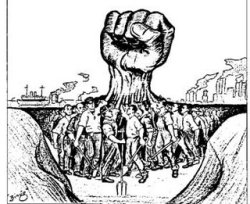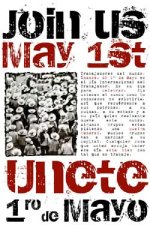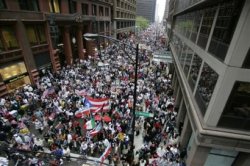Roe v. Wade Day #34
Today is the 34th anniversary of the Supreme Court’s decision in Roe v. Wade. In honor of the day there is a lot I want to say about abortion rights, and also an important announcement I want to make about a new project. But the dialectic and the announcement will both have to wait until the next couple days thanks to the demands of work; for now, I will mostly be repeating what I said last year.
There’s a lot not to like about the specifics of the reasoning in Roe, and it’s sometimes frustrating that Roe is the ruling that we’ve got to celebrate, or at least defend. But the decision did concretely take the boots of the male State from off the necks of millions of women across the United States. January 22 is a jubilee day, representing one of the chief victories of a remarkable, explosive struggle — which took place over the course of just under 4 years, from the decisive beginning of the feminist pro-choice movement in early 1969, to the decision in January 1973. (There was a small, barely effectual abortion law reform movement before 1969; but February and March 1969 marked the beginning of the abortion law repeal movement, and also the beginning of the pro-choice argument — that is, early 1969 is when the argument shifted from the old tack of getting people to feel sorry for the poor desperate girl, to the new demand by radicalized women for their right to the determine how their own bodies will or will not be used.)

Like most anniversaries, this one is partly about remembering and honoring. Today there are three things that I want you to remember, or to learn.
First, you should know all about two months that made all the difference. This is from Susan Brownmiller’s In Our Time: Memoir of a Revolution:
February 1969 was an important month in the abortion struggle. Larry Lader, a biographer of Margaret Sanger, summoned a handful of professionals in law and medicine to the Drake Hotel in Chicago for the organizing conference of NARAL, the National Association for Repeal of Abortion Laws. (NARAL became the National Abortion Rights Action League in 1974.) The conferees targeted specific states where they believed the repressive codes could be knocked down. New York, with its liberal constituency, was a top priority. Bills ranging from modest reforms (in cases of rape and incest) to outright repeal of all criminal penalties were already in the legislative hopper.
Betty Friedan, one of the main speakers at the Chicago NARAL meeting, reflected the changing political climate. At NOW’s founding convention in 1966, she had bowed to a clique that insisted that abortion rights were too divisive, too sexual, and too controversial for the fledgling organization, but since then a groundswell of younger members had stiffened her spine. NOW was being inundated by
kids,one member observed. Thekidsfrom New York, Michigan, Ohio, Texas, and elsewhere pushed through an abortion plank at NOW’s 1967 convention.And the
kidswere forging ahead with their own tactics. On the same wintry day in mid-February when NARAL’s founders were traveling to Chicago for their first conference six state legislators held a public hearing in Manhattan on some proposed liberalizing amendments to the New York law. Typical of the times, the six legislators were men, and the spekaers invited to present expert testimony were fourteen men and a Catholic nun.On the morning of the February 13 hearing, a dozen infiltrators camouflaged in dresses and stockings entered the hearing room and spaced themselves around the chamber. Some called themselves Redstockings, and some, like Joyce Ravitz, wre free-floating radicals who were practiced hands at political disruptions. Ravitz, in fact, had been on her way to another demonstration when she’d run into the Redstockings women, who convinced her to join them.
As a retired judge opined that abortion might be countenanced as a remedy after a woman had
fulfilled her biological service to the communityby bearing four children, Kathie Amatniek leaped to her feet and shouted,Let’s hear from the real experts–women!Taking her cue, Joyce Ravitz began to declaim an impassioned oration. Ellen Willis jumped in. More women rose to their feet.
Men don’t get pregnant, men don’t bear children. Men just make laws,a demonstrator bellowed.
Why are you refusing to admit we exist?cried another.
Girls, girls, you’ve made your point. Sit down. I’m on your side,a legislator urged, raising the temperature a notch higher.
Don’t call us girls,came the unified response.We are women!The hearing dissolved in confusion. When the chairman attempted to reconvene it behind closed doors, the women sat down in the corridor, refusing to budge.
Stories appeared the next day in the Times (Women Break Up Abortion Hearing), the New York Post (Abortion Law Protesters Disrupt Panel), and the Daily News. Ellen Willis slipped out of her activist guise to do a report for Talk of the Town in The New Yorker. Nanette Rainone filed for WBAI radio and the Pacfica network. Barely a month old, Redstockings, with an assist from the radical floaters, had successfully dramatized the need for
woman as expertin the abortion debate.Five weeks later, on March 21, 1969, Redstockings staged a public speak-out,
Abortion: Tell It Like It Is,at the Washington Square Methodist Church, a hub of antiwar activism in Greenwich Village. For some Women’s Liberation founders, the speak-out was the movement’s finest hour.Astounding,is the way Irene Peslikis puts it.It showed the power of consciousness-raising, how theory comes from deep inside a person’s life, and how it leads directly to action.Peslikis had organized the panel and coached the women who were willing to speak.
The idea,she says,was to get examples of different kinds of experiences–women who’d had the babies that were taken away, women who went to the hospital for a therapeutic abortion, women who’d gone the illegal route, the different kinds of illegal routes.Three hundred women and a few men filled the church that evening as Helen Kritzler, Barbara Kaminsky, Rosalyn Baxandall, Anne Forer, and a few other brave souls passed a small microphone back and forth. Baxandall broke the ice with a touch of humor.
I thought I was sophisticated,she joked into the mike.My boyfriend told me if he came a second time, the sperm would wash away, and I believed him.Another woman recounted,
So there I was in West New York, New Jersey, and the doctor had these crucifixes and holy pictures on the wall, and all he wanted was nine hundred dollars. I took out a vacation loan and I’m still paying it off.Judy Gabree hurtled forward.
I went to eleven hospitals searching for a therapeutic abortion. At the tenth, they offered me a deal. They’d do it if I agreed to get sterilized. I was twenty years old. I had to pretend I was crazy and suicidal, but having the abortion was the sanest thing I’d done.More women added their personal testimony. I was one of those who kept quiet. Irene Peslikis had asked me to be one of the speakers, but I chose an easier path and played Village Voice reporter. My front-page story, Everywoman’s Abortions: The Oppressor Is Man, was the only substantive coverage the landmark speak-out received. Some retyped it in Chicago for the Voice of the Women’s Liberation Movement newsletter, which carried the news to activists around the country.
Another journalist, in aviator glasses and a miniskirt, was taking notes in the church that evening. She hovered near Jane Everhart, a NOW member, and whispered
What’s going on?Everhart whispered back,
Sit down and listen!Gloria Steinem was a friend of Women’s Liberation in 1969, but she had not yet thrown in her lot with the movement. Her plate was already overflowing with causes. Gloria spoke out against the war in Vietnam on late-night talk shows, raised money for liberal Democrats and Cesar Chavez’s farmworkers, and wrote earnest pieces on all of her issues for the popular magazines. Genetically endowed with the rangy limbs and sculpted features of a fashion model, Steinem glided through the rarefied world of radical chic expertly building her political connections. Beneath the exterior of the celebrity journalist was a woman who yearned to save the world.
Steinem received a shock of recognition when a Redstocking quipped,
I bet every woman here has had an abortion.Hers had been done by a Harley Street practitioner in London during the late fifties after she’d graduated from Smith. Later she would say that the speak-out was her feminist revelation, the moment that redirected her public path. That night, however, she was working on a tight deadline. She threw together a hasty paragraph for the political diary she wrote for New York magazine.Nobody wants to reform the abortion laws,she explained in print.They want to repeal them. Completely.The Redstockings abortion speak-out was an emblematic event for Women’s Liberation. Speak-outs based on the New York women’s model were organized in other cities within the year, and subsequent campaigns to change public opinion in the following decade would utilize first-person testimony in a full range of issues from rape and battery to child abuse and sexual harassment. The importance of personal testimony in a public setting, which overthrew the received wisdom of
the experts,cannot be overestimated. It was an original technique and a powerful ideological tool. Ultimately, of course, first-person discourse on a dizzying variety of intimate subjects would become a gimmicky staple of the afternoon television talk shows, where the confessional style was utilized for its voyeuristic shock value. Back then, personal testimony was a political act of great courage.–Susan Brownmiller, In Our Time: Memoir of a Revolution, pp. 106–109
Second, you should know why they were out there, putting themselves on the line for this, and why doing that had such a remarkable impact in so short of a time. I think we can find some of the reasons in Lucinda Cisler’s wonderful, hauntingly prescient Abortion law repeal (sort of): a warning to women (1969).
… The most important thing feminists have done and have to keep doing is to insist that the basic reason for repealing the laws and making abortions available is justice: women’s right to abortion.
… Until just a couple of years ago the abortion movement was a tiny handful of good people who were still having to concentrate just on getting the taboo lifted from public discussions of the topic. They dared not even think about any proposals for legal change beyond
reform(in which abortion is grudgingly parceled out by hospital committee fiat to the few women who canprovethey’ve been raped, or who are crazy, or are in danger of bearing a defective baby). They spent a lot of time debating with priests about When Life Begins, and Which Abortions Are Justified. They were mostly doctors, lawyers, social workers, clergymen, professors, writers, and a few were just plain women—usually not particularly feminist.Part of the reason the reform movement was very small was that it appealed mostly to altruism and very little to people’s self-interest: the circumstances covered by
reformare tragic but they affect very few women’s lives, whereas repeal is compelling because most women know the fear of unwanted pregnancy and in fact get abortions for that reason.… These people do deserve a lot of credit for their lonely and dogged insistence on raising the issue when everybody else wanted to pretend it didn’t exist. But because they invested so much energy earlier in working for
reform(and got it in ten states), they have an important stake in believing that their position is therealisticone—that one must accept the small, so-calledsteps in the right directionthat can be wrested from reluctant politicians, that it isn’t quite dignified to demonstrate or shout what you want, that raising the women’s rights issue willalienatepoliticians, and so on.Because of course, it is the women’s movement whose demand for repeal—rather than
reform—of the abortion laws has spurred the general acceleration in the abortion movement and its influence. Unfortunately, and ironically, the very rapidity of the change for which we are responsible is threatening to bring us to the point where we are offered something so close to what we want that our demands for radical change may never be achieved.–Lucinda Cisler, Abortion law repeal (sort of): a warning to women, ¶Â¶ 2–10
Cisler goes on to review four different restrictions or limitations on abortion-law repeal that she thinks could make for just this sort of roadblock. One of the best sections in the essay is her discussion a restriction with which we are all too familiar in the post-Roe world:
3: Abortions may not be performed beyond a certain time in pregnancy, unless the woman’s life is at stake. Significantly enough, the magic time limit varies from bill to bill, from court decision to court decision, but this kind of restriction essentially says two things to women: (a) at a certain stage, your body suddenly belongs to the state and it can force you to have a child, whatever your own reasons for wanting an abortion late in pregnancy; (b) because late abortion entails more risk to you than early abortion, the state must
protectyou even if your considered decision is that you want to run that risk and your doctor is willing to help you. This restriction insults women in the same way the presentpreservation-of-lifelaws do: it assumes that we must be in a state of tutelage and cannot assume responsibility for our own acts. Even many women’s liberation writers are guilty of repeating the paternalistic explanation given to excuse the original passage of U.S. laws against abortion: in the nineteenth century abortion was more dangerous than childbirth, and women had to be protected against it. Was it somehow less dangerous in the eighteenth century? Were other kinds of surgery safe then? And, most important, weren’t women wanting and getting abortions, even though they knew how much they were risking?Protectionhas often turned out to be but another means of control over the protected; labor law offers many examples. When childbirth becomes as safe as it should be, perhaps it will be safer than abortion: will we put back our abortion laws, toprotect women?… There are many reasons why a woman might seek a late abortion, and she should be able to find one legally if she wants it. She may suddenly discover that she had German measles in early pregnancy and that her fetus is deformed; she may have had a sudden mental breakdown; or some calamity may have changed the circumstances of her life: whatever her reasons, she belongs to herself and not to the state.
–Lucinda Cisler, Abortion law repeal (sort of): a warning to women, ¶Â¶ 19, 21
Third, you should know what the women of Jane did in Chicago to help make their sisters’ ownership of their own bodies a reality, without the blessing of the male experts
and in defiance of the male State. Here’s Brownmiller, again:
Radical women in Chicago poured their energy into Jane, an abortion referral service initiated by Heather Booth, who had been a one-woman grapevine for her college classmates. In 1971, after Booth’s departure, some of the women took matters into their own hands and secretly began to perform the abortions themselves. Safe, compassionate terminations for a modest fee became their high calling–a model, as they saw it, for women’s empowerment after the revolution.
Leaflets appeared in the Hyde Park neighborhood of the University of Chicago bearing a simple message:
Pregnant? Don’t want to be? Call Jane at 643-3844.The number rang at the home of one of the activists who volunteered to beJane.As word spread and the volume of calls increased, the service acquired its own phone line and an answering machine, a cumbersome reel-to-reel device that was one of the first on the market. Volunteers, known inside the service ascall-back Janes,visited the abortion seekers to elicit crucial medical details (most important waslmp,the number of weeks since the last menstrual period), then another level of volunteers scheduled an appointment with one of the abortionists on the group’s list.At first the service relied on
Mike in Cicero,who was fast, efficient, and willing to lower his price to five hundred dollars as the volume increased. Mike gradually let down his guard with Jody Parsons, his principal Jane contact, an artisan who sold her beaded jewelry and ceramics at street fairs and was a survivor of Hodgkin’s disease. The clandestine abortionist and the hippy artisan struck up a bond. When Mike confessed that he was not in fact a real doctor but merely a trained technician, she cajoled him into teaching her his skills. Jody’s rapid success in learning to maneuver the dilating clamps, curettes, and forceps demystified the forbidden procedures for another half dozen women in Jane.If he can do it, then we can do itbecame their motto.Madeline Schwenk, a banker’s daughter who had married at twenty,
six months pregnant with no clue whatsoever about how to get an abortion,moved from counseling to vacuum aspiration after Harvey Karman, the controversial director of a California clinic, came to Chicago to demonstrate his technique. Madeline was one of the few women in Jane who was active in NOW, and who stayed affiliated with the Chicago chapter during the year she wielded her cannula and curette for the service.I’d get up in the morning, make breakfast for my three kids, go off to do the abortions, then go home to make dinner,she reminisces.Pretty ourageous behavior when you think about it. But exciting.Jane’s abortion practitioners and their assistants were able to handle a total of thirty cases a day at affordable fees–under one hundred dollars. A doctor and a pharmacist among the women’s contacts kept them supplied with antibiotics.
Fear of police surveillance in radical circles had its match among clandestine abortionists who relied on a complicated rigamarole of blindfolds and middlemen. Jane straddled both worlds. Abortion seekers gathered every Wednesday, Thursday, and Friday at a
frontapartment, usually the home of a Jane member or friend, and were escorted by Jane drivers tothe Place,a rented apartment where the abortions were performed. The fronts and the Place changed on a regular basis. New volunteers, brought into the group by counselors and drivers, went through a probation period before they were told that women in Jane were doing the abortions. The news did not sit well with everyone. Turnover was high, from fear and from burnout, although the service usually maintained its regular complement of thirty members.Jane lost most of its middle-class clientele after the New York law [repealing the state’s abortion ban] went into effect. Increasingly it began to service South Side women, poor and black, who did not have the money to travel out of state, and whose health problems, from high blood pressure to obesity, were daunting. Pressure on the providers intensified. Audaciously they added second-trimester abortionsby induced miscarriage to their skills.
On May 3, 1972, near the conclusion of a busy work day in an eleventh-floor apartment on South Shore Drive overlooking Lake Michigan, Jane got busted. Seven women, including Madeline Schwenk, were arrested and bailed out the following day. The Chicago Daily News blared Women Seized in Cut-Rate Clinic in a front-page banner. The Tribune buried Lib Groups Linked to Abortions on an inside page. Six weeks later the service was back in buinsess. Wisely, the women facing criminal charges selected a defense attorney who was clued in to and optimistic about the national picture. She advised them to hang tight–some interesting developments were taking place in Washington that could help their case. (After the January 1973 Roe decision, all outstanding charges against the seven were dropped.)
The activists of Jane believe they performed more than ten thousand abortions. It’s a ballpark figure based on the number of procedures they remember doing in a given week. For security reasons they did not keep records.
–Susan Brownmiller, In Our Time: Memoir of a Revolution, pp. 123–125
It’s important to remember that, although the occasion for celebrating January 22 is a Supreme Court decision, the repeal of abortion laws wasn’t a gift handed down out of benevolence by a gang of old men in robes. It was struggled for, and won, by women in our own times. Women who stood up for themselves, who challenged the authority of self-appointed male experts
and law-makers, who spoke truth to power. Radical women who took things into their own hands and helped their sisters, in defiance of the law, because they knew that they had a right to do it. Radical feminists who built a movement for their own freedom over a matter of months and decisively changed the world in less than five years. It’s not just that we owe Kathie Sarachild, Joyce Ravitz, Ellen Willis, Cindy Cisler, Heather Booth, Jody Parsons, Madeline Schwenk, and so many others our praise. They do deserve our cheers, but they also deserve our study and our emulation. They did amazing things, and we — feminists, leftists, anti-statists — owe it not only to them, but to ourselves, to honor them by trying to learn from their example.
Further reading:
- GT 2004-01-22: Happy birthday to Roe!
- GT 2004-03-08: April March
- GT 2004-06-24: Pro-choice on Everything, Part I
- GT 2004-11-18: Culture of Life
- GT 2005-01-22: Roe v. Wade Day #32
- GT 2005-01-26: Let the hand-wringing begin
- GT 2005-03-10: Don’t they know abortion is illegal in this country?
- GT 2005-11-03: Goodbye to All That. Again.
- GT 2006-01-22: Roe v. Wade Day #33
- GT 2006-02-16: Other people’s wombs
- GT 2006-03-08: Abortion on demand and without apology (Dakota Remix)
- GT 2006-04-30: Over My Shoulder #21: Kathie Sarachild, The Power of History, in Feminist Revolution (1975)



